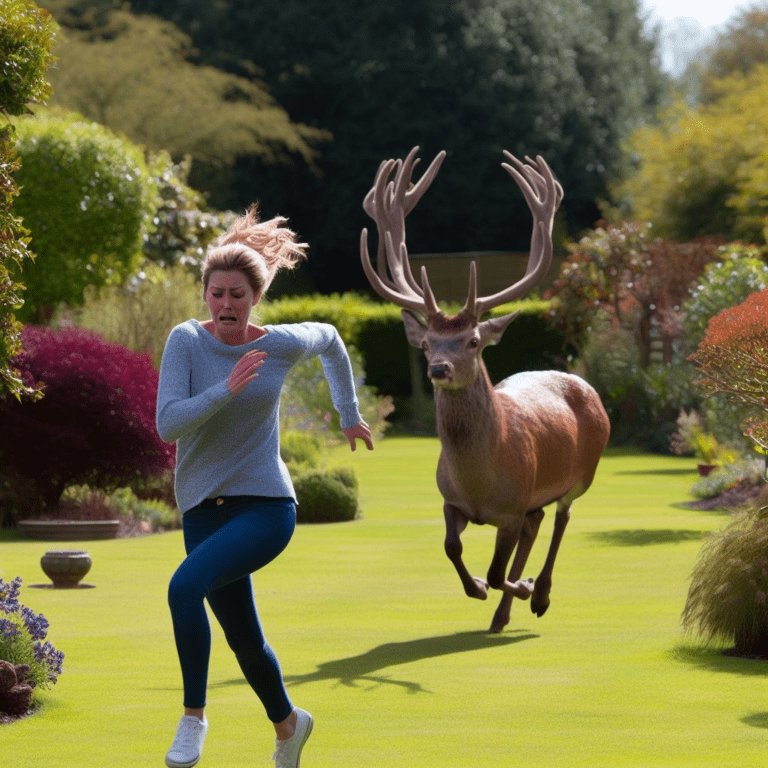
Imagine hiking through a serene forest, surrounded by the sounds of nature. Suddenly, you spot a group of red deer gracefully grazing nearby. They appear calm and peaceful, but what would happen if you got too close? Let me explain why understanding their behavior is essential for staying safe in their territory, especially during certain times of the year.
Understanding Red Deer Behavior
Red deer are generally calm and shy animals, preferring to avoid human interaction. However, several factors can lead to aggressive behaviors. One of the main reasons red deer might become dangerous is during the rutting season, which occurs in the fall. During this time, males compete for mates, and their testosterone levels rise, making them more territorial and aggressive.
You might be wondering what this looks like in real life. Picture a male red deer, or stag, during the rut. With their antlers fully developed and their bodies charged with energy, they can be quite confrontational. They might engage in fierce battles with other stags, showcasing their strength and dominance. If they perceive any threat, they can become aggressive not just towards other deer but towards humans as well.
Another aspect to consider is a mother deer with her young. Mother red deer are incredibly protective of their calves. If you come between a mother and her fawn, you could be seen as a threat, prompting a potentially dangerous encounter.
When Do Red Deer Become a Threat?
While the majority of encounters with red deer are harmless, a few situations can escalate to danger. Knowing when these scenarios unfold is key to avoiding conflicts.
1. Rutting Season: As mentioned, this is when stags are most aggressive. If you’re in an area where deer are known to be active during the fall, it’s wise to keep your distance. This usually lasts from late September to early November, depending on the region, so plan your hikes accordingly.
2. Proximity to Young: If you stumble upon a mother deer with her fawn, it’s best to keep your distance and quietly back away. You might think that a young fawn looks abandoned, but the mother is often nearby, watching closely. Approaching can trigger a protective response, and here’s the thing: a mother deer can be just as fierce as any wild animal when it comes to her young.
3. Feeling Cornered: Deer, like many animals, have a flight response when they feel threatened. If a deer feels it has nowhere to go, it may act aggressively to defend itself. Avoid situations where a deer might feel trapped, such as approaching it in a confined area or blocking its escape route.
Signs of an Aggressive Red Deer
Recognizing the warning signs of aggressive behavior is crucial for your safety. Here are a few things to watch for:
- Antler Display: During the rut, male deer will often show off their antlers to establish dominance. If you see a stag puffing itself up or making loud noises, it’s best to keep a safe distance.
- Snorting or Growling: These sounds can signal that a deer feels threatened and is ready to defend itself.
- Posturing: An aggressive deer may lower its head, stomp its feet, or even charge. If you see these actions, it’s a clear warning to back off.
By staying alert to these signs, you can avoid putting yourself in harm’s way while enjoying the beauty of these magnificent animals.
What to Do If You Encounter a Red Deer
If you find yourself face-to-face with a red deer, don’t panic! Most encounters don’t end in aggression if you handle them correctly. Here’s how to manage the situation:
1. Give Space: The first thing to do is give the deer space. Don’t approach them, especially if they seem agitated or protective. Stand still and keep your distance to prevent escalating the situation.
2. Back Away Slowly: If the deer continues to show signs of aggression, back away slowly while facing the animal. Sudden movements can startle it, leading to a defensive reaction.
3. Stay Calm: It’s easy to get anxious when facing a wild animal, but try to remain calm. If you’re with others, keep your voices low and avoid sudden outbursts. This can help de-escalate any tension.
4. Take an Alternate Route: If you see a group of deer ahead on your hiking path, consider taking another route. This way, you minimize any chance of interaction that could lead to aggression.
Comparing Red Deer to Other Wildlife
When talking about dangerous animals, it’s helpful to compare red deer to others like bears or moose. While bears are known for their aggressive behavior and can attack if they feel threatened, red deer are different. They generally prefer to flee rather than fight. Moose, on the other hand, can become aggressive, especially during their mating season.
Here’s a quick comparison:
| Animal | Behavior | Danger Level |
|---|---|---|
| Red Deer | Shy, aggressive during rut and with young | Low to Moderate |
| Bears | Can be aggressive when threatened | High |
| Moose | May charge if startled or during mating season | Moderate to High |
Understanding these differences can help you navigate wildlife encounters while hiking or exploring nature.
In summary, red deer can indeed be dangerous to humans under specific circumstances, particularly during the rutting season or when they’re protecting their young. However, with a little awareness and caution, you can enjoy observing these beautiful animals from a safe distance. Knowing how to read their body language and understanding their behavior can make all the difference in your outdoor adventures.
So next time you’re out in the wild and spot a red deer, take a moment to appreciate their grace while keeping a respectful distance. Remember, nature is best enjoyed with a healthy dose of respect and caution—you’ll be much safer that way!

